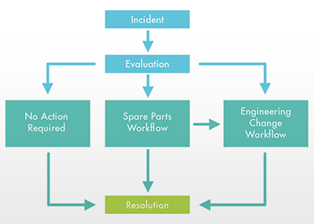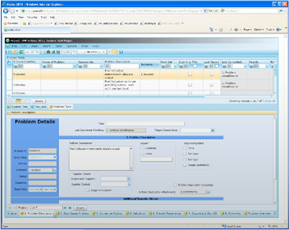Oerlikon Solar: Trübbach, Switzerland
With over 850 employees in 20 locations around the world, Oerlikon Solar is one of six business segments within Oerlikon Corporation, a 20,000-employee world leader in production systems, components, and services for thin film, vacuum, drive systems, textile manufacturing, and precision technology products. Oerlikon Solar designs, produces, installs, and supports manufacturing lines for solar panels. Their turnkey production lines are highly automated, completely configurable, and must comply with the high standards for quality imposed both by Oerlikon's own product warranty and by their customers' industrial standards.
The Case
Oerlikon Solar selected Windchill Risk and Reliability to systematically track the occurrence, analysis, and resolution of failures and incidents for solar panel manufacturing equipment. In addition to requiring a high degree of communication between field personnel responsible for installation or maintenance and in-house engineers responsible for analysis and resolution, Oerlikon required a system that could automatically track system metrics and keep account managers apprised of the condition of their customers' systems. This functionality helps the company meet its high system uptime requirements, which are part of both its company-wide commitment and its product warranty.
Identifying the Stakeholders and Goals of the Risk and Reliability
An essential first step in implementing any Risk and Reliability is to identify the key personnel who will need to be involved in the system, and to pinpoint their responsibilities throughout the process of discovering, reporting, evaluating, analyzing, and correcting any failures or incidents that might occur. In this case, these are:
- Field personnel who complete installation, repairs, and maintenance are responsible to report failures or incidents
- In-house engineering staff in a variety of roles evaluate incidents, analyze their root causes, and propose design changes to help achieve a long-term improvement in quality
- Other personnel responsible for supporting the on-site team order and deliver the necessary spare parts for an immediate solution
- Worldwide account managers responsible for customer service and satisfaction need access anytime, anywhere to monitor system uptime and ensure product warranty goals are being met
A variety of other stakeholders need to participate in the Risk and Reliability as required, including managers responsible for signing off on recommended changes, system engineers responsible for root-cause analysis and design modifications, and individuals responsible for keeping spare parts stocked, among others.
Implementing Windchill Risk and Reliability Solutions to Meet Goals
Each of these specified goals can be achieved using features and functions available in Windchill Risk and Reliability. And thanks to its high degree of flexibility, Windchill Risk and Reliability can be configured without the need for programming skills to ensure the software workflow matches each stated business need. The goals of the company and the software functionality leveraged to fulfill them are:
- Communicate issues from field personnel: Remote login to Windchill Risk and Reliability via a Web-based interface ensures that field personnel responsible for installation and maintenance can report issues from any Internet browser
- Track multiple system configurations: In Windchill Risk and Reliability, it is possible to model a system and its component parts and assemblies once, and then define many different configurations of that system and track them independently, allowing personnel to associate issues with a particular system configuration
Managing workflows with subtables in Windchill Risk and Reliability:
In this case, incidents initiated by on-site field personnel are forwarded to an evaluation process, which determines action to take: No Action, Spare Parts Workflow for an immediate parts solution, and/or Engineering Change Workflow for long-term quality improvement. The ability to associate an incident with two workflows simultaneously, each with their own workflow and level of complexity, is effected using subtables and problem tables. Problem tables provide for the association of like incidents that will be solved by the same design change.
- Evaluate the severity of an issue: Once an issue is reported in the Risk and Reliability, appropriate in-house personnel are notified by an automatically generated workflow email and can evaluate the severity of the issue, escalating it to one or more successive workflows or closing it out if it is deemed resolved
- Respond to any immediate need for spares or repairs: If it is determined that immediate spares or repairs are needed, subtables in Windchill Risk and Reliability are used to advance the issue to a separate workflow for the pricing, approval, ordering, procurement, and delivery of parts
- Improve overall system quality: Simultaneously, if it is determined that the issue requires additional quality checks or design changes to improve the overall system for the future, problems tables in Windchill Risk and Reliability make it possible to escalate the issue and associate it with other related issues; problems are also addressed by a separate workflow, initiating an iterative process among multiple personnel responsible for analysis, proposed design changes, change review and approval, and management sign-off
- Calculate system metrics to track uptime and downtime: Automatic calculations within Windchill Risk and Reliability keep track of key system metrics for each configuration of a system in the field, including MTBF and failure rate; in addition, user-defined calculations may be implemented to track system uptime and downtime, including the percentage of uptime and downtime due to various causes, in order to ensure that warranty goals are met
- Trend overall system improvement: Using graphing and reporting capabilities available both in-house and online, individuals at many levels throughout the organization can create
 graphs and reports tracking trends for a wide range of system metrics, including improvement in the overall reliability of the system over time as a result of the Risk and Reliability
graphs and reports tracking trends for a wide range of system metrics, including improvement in the overall reliability of the system over time as a result of the Risk and Reliability
- Gain remote access to key system metrics: Also via remote log-in from an Internet browser, account managers are able to access the online dashboard available in Windchill Risk and Reliability to view graphs and reports of these metrics and to track a system's compliance with the company's product warranty
- Ensure timely response to both immediate issues and quality improvement: Alert notification functionality regularly monitors the system for user-defined thresholds– such as number of open incidents, overdue incidents, impending deadlines, system downtime levels, etc.–and automatically generates an email to specified personnel when conditions are met, helping to ensure timely response at any stage in the workflow
Ensuring the Success of the Risk and Reliability
Ensuring the success of the system is a major goal of any Risk and Reliability implementation. Built-in features in Windchill Risk and Reliability contribute to system success by offering ease of use, standardized processes, streamlined data entry, and the security and integrity of data. The goals for ensuring a successful system, and the features in Windchill Risk and Reliability that help meet these goals, are:
- Streamline data entry: Configurable data entry forms that include features like user-defined fields, choice list options, and auto-populate features are all available in Windchill Risk and Reliability to minimize the possibility of human error, facilitate fast and easy data entry, and help ensure the standardization of records
- Specify user-based login permissions: Users and groups can be defined with administrator tools in Windchill Risk and Reliability to ensure that each user can only access and edit the forms and information necessary for their step in the Risk and Reliability process, helping to maintain data security and integrity
- Provide data traceability and security with audit tracking: Additional security features include audit trail capabilities, which can track every change made to an entry, helping ensure both the security and the traceability of incidents in the Risk and Reliability
The Results
The features and functionality of Windchill Risk and Reliability contribute to meeting the business goals of Oerlikon Solar for enhanced communication, timely customer response, and improved system reliability. Windchill Risk and Reliability enables workflow configurability to match Oerlikon Solar's specific business needs for timely parts replacement as well as quality assurance and improved product design. And communication features ensure that field technicians can contribute incidents, inhouse engineers can address them, and account managers throughout various locations can track system metrics, allowing for a corrective action system that efficiently addresses every reported incident.
About Windchill Risk and Reliability
Windchill Risk and Reliability is a comprehensive, closed loop corrective action software tool that enables you to collect, quantify, and control a wide range of incoming incident reports, such as test, field, or repair data. Windchill Risk and Reliability streamlines your corrective action processes, including incident analysis, root cause determination, incident close-out, trend analysis, and corrective action tracking. Supporting a wide range of processes and compliance standards, such as ISO 9000, 8D, and RMAs, Windchill Risk and Reliability offers a robust, scalable system which can be tailored to your requirements. Features include customizable data entry and outputs, workflow support, security and role based permissions, custom calculations, reliability analytics, a zero-client web-based user interface, data connectivity, reliability growth calculations, and alert capabilities.